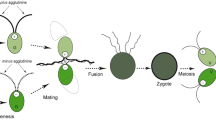Summary
We describe a circadian rhythm in the surface density of receptors that play a dominant role in the mating process of the unicellular green alga Chlamydomonas eugametos.These receptors — called agglutinins — are large glycoproteins extrinsically bound to the membrane of gamete flagella. We found circadian fluctuations in their density. Since inhibition of protein synthesis affected the agglutinin density without a lag period at any time,we conclude that the density was dependent on de novo synthesis and that the fluctuations in density are caused by circadian oscillations in the rate of agglutinin synthesis. This phenomenon evidently underlies the pronounced endogenous rhythm in mating competence that we described previously (Demets et al. 1987). Finally, we speculate on the nature of the time keeping mechanism that is generating these rhythmic events.
Similar content being viewed by others
References
Bouck GB (1971) The structure, origin, isolation and composition of the tubular mastigonemes of the Ochromonas flagellum. J Cell Biol 50:362–384
Bruce VG (1970) The biological clock in Chlamydomonas reinhardii. J Protozool 17:328–334
Coleman AW (1979) Sexuality in colonial green flagellates. In: Levandowsky M, Hutner SH (eds) Biochemistry and physiology of protozoa, vol 1. Academic Press, New York London, pp 307–340
Crabbendam KJ, Klis FM, Musgrave A, Ende H van den (1986) Ultrastructure of the plus- and minus sexual agglutinins of Chlamydomonas eugametos, as visualized by negative staining. J Ultrastruct Res 96:151–159
Demets R, Tomson AM, Ran ETH, Sigon CAM, Stegwee D, Ende H van den (1985) Synchronization of the cell division cycle of Chlamydomonas eugametos. J Gen Microbiol 131:2919–2924
Demets R, Tomson AM, Stegwee D, Ende H van den (1987) Control of the mating competence rhythm in Chlamydomonas eugametos. J Gen Microbiol 133:1081–1088
Ende H van den (1985) Sexual agglutination in Chlamydomonads. In: Rose AH, Tempest DW (eds) Advances in microbiol physiology, vol 26. Academic Press, London New York, pp 89–123
Hoffmans-Hohn M, Martin W, Brinkmann K (1984) Multiple periodicities in the circadian system of unicellular algae. Z Naturforsch 39C:791–800
Homan WL, Musgrave A, Molenaar EM, End H van den (1980) Isolation of monovalent sexual binding components from Chlamydomonas eugametos flagellar membranes. Arch Microbiol 128:120–125
Homan W, Musgrave A, Nobel H de, Wagter R, Wit D de, Kolk A, Ende H van den (1988) Monoclonal antibodies directed against the sexual binding site of Chlamydomonas eugametos gametes. J Cell Biol(in press)
Klis FM, Samson MR, Touw E, Musgrave A, Ende H van den (1985) Sexual agglutination in the unicellular green alga Chlamydomonas eugametos. Identification and properties of the mating type plus agglutination factor. Plant Physiol 79:740–746
Laemmli UK (1970) Cleavage of structural proteins during the assembly of the head of bacteriophage T4. Nature 227:680–685
McFadden GI, Melkonian M (1986) Golgi apparatus activity and membrane flow during scale biogenesis in the green flagellate Scherffelia dubia (Prasinophyceae). I. Flagellar re-generation. Protoplasma 130:186–198
Mesland DAM (1976) Mating in Chlamydomonas eugametos. A scanning electron microscopical study. Arch Microbiol 109:31–35
Musgrave A, Eijk E van, Welscher R te, Broekman R, Lens PF, Homan WL, Ende H van den (1981) Sexual agglutination factor from Chlamydomonas eugametos. Planta 153:362–369
Musgrave A, Wildt P de, Etten I van, Pijst H, Scholma C, Kooijman R, Homan W, Ende H van den (1986) Evidence for a functional membrane barrier in the transition zone between the flagellum and cell body of Chlamydomonas eugametos gametes. Planta 167:544–553
Pijst HLA, Zilver RJ, Musgrave A, Ende H van den (1983) Agglutination factor in the cell body of Chlamydomonas eugametos. Planta 158:403–409
Saito T, Tsubo Y, Matsuda Y (1985) Synthesis and turnover of cell-body agglutinin as a pool of flagellar surface-agglutinin in Chlamydomonas reinhardii. Arch Microbiol 142:207–210
Schweiger HG, Schweiger M (1977) Circadian rhythms in unicellular organisms: an endeavour to explain the molecular mechanism. Int Rev Cytol 51:315–342
Schweiger HG, Hartwig R, Schweiger M (1986) Cellular aspects of circadian rhythms. J Cell Sci [Suppl] 4:181–200
Snell WJ, Moore WS (1980) Aggregation-dependent turnover of flagellar adhesion molecules in Chlamydomonas gametes. J Cell Biol 84:203–210
Straley SC, Bruce VG (1979) Stickiness to glass. Circadian changes in the cell surface of Chlamydomonas reinhardii. Plant Physiol 63:1175–1181
Tomson AM, Demets R, Bakker NPM, Stegwee D, Ende H van den (1985) Gametogenesis in liquid cultures of Chlamydomonas eugametos. J Gen Microbiol 131:1553–1560
Tomson AM, Demets R, Sigon CAM, Stegwee D, Ende H van den (1986) Cellular interactions during the mating process in Chlamydomonas eugametos. Plant Physiol 81:522–526
Wiese L (1984) Mating systems in unicellular algae. In: Lins-kens HF, Heslop-Harrison J (eds) Cellular interactions. (En-cyclopedia of plant physiology, NS, vol 17) Springer, Berlin Heidelberg New York, pp 238–260
Witman GB, Carlson K, Berliner J, Rosenbaum JL (1972) Chlamydomonas flagella. I. Isolation and electrophoretic analysis of microtubules, matrix, membranes and mastigonemes. J Cell Biol 54:507–539
Zacharius RM, Zell TE, Morrison JM, Woodlock JJ (1969) Glycoprotein staining following electrophoresis on acrylamide gels. Anal Biochem 30:148–152
Author information
Authors and Affiliations
Rights and permissions
About this article
Cite this article
Tomson, A.M., Demets, R., Homan, W.L. et al. Endogenous oscillator controls surface density of mating receptors in Chlamydomonas eugametos . Sexual Plant Reprod 1, 46–50 (1988). https://doi.org/10.1007/BF00227022
Issue Date:
DOI: https://doi.org/10.1007/BF00227022




